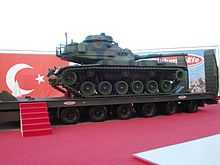M60 Patton
| M60 Patton | |
|---|---|
 An M60A3 Patton on display in Lake Charles, Louisiana, in April 2005. | |
| Type | Main battle tank |
| Place of origin |
|
| Service history | |
| In service | 1961-1997 (United States) |
| Used by | See Operators |
| Wars |
Vietnam War Yom Kippur War Iran–Iraq War Persian Gulf War Western Sahara War Shia insurgency in Yemen |
| Production history | |
| Manufacturer | Detroit Arsenal Tank Plant, Chrysler |
| Produced | 1960–1987 |
| Number built | Over 15,000 (all variants) |
| Variants | See Variants |
| Specifications | |
| Weight |
M60: 50.7 short tons (46.0 t; 45.3 long tons) M60A1: 52 to 54 short tons (47 to 49 t; 46 to 48 long tons) depending on turret design. |
| Length | M60: 6.946 meters (22 ft 9.5 in) (hull), 9.309 meters (30 ft 6.5 in) (gun forward)[1] |
| Width | M60: 3.631 meters (11 ft 11.0 in)[1] |
| Height | M60: 3.213 meters (10 ft 6.5 in)[1] |
| Crew | 4 |
|
| |
| Armor | 6.125 in (155.6 mm) |
Main armament |
105 mm (4.1 in) M68 gun (M60/A1/A3) 152 mm (6.0 in) M162 Gun/Launcher (M60A2) |
Secondary armament |
.50 cal (12.7 mm) M85 7.62 mm M73 machine gun |
| Engine |
Continental AVDS-1790-2 V12, air-cooled Twin-turbo diesel engine 750 bhp (560 kW)[1] |
| Power/weight | 15.08 bhp/t[1] |
| Transmission | General Motors, cross-drive, single-stage with 2 forward and 1 reverse ranges[1] |
| Suspension | Torsion bar suspension |
| Ground clearance | 0.463 meters (1 ft 6.2 in)[1] |
| Fuel capacity | 1,457 liters (320 imp gal; 385 U.S. gal)[1] |
Operational range | 300 miles (500 km)[1] |
| Speed | 30 miles per hour (48 km/h) (road)[1] |
The M60 Patton, officially the 105 mm Gun Full Tracked Combat Tank, M60,[2] is a main battle tank (MBT)[3] introduced in December 1960.[4] It was widely used by the U.S. and its Cold War allies, especially those in NATO, and remains in service throughout the world today despite having been superseded by the M1 Abrams in the U.S. military. Egypt is currently the largest operator with 1,716 upgraded M60A3s, Turkey is second with 866 upgraded units in service, and Israel is third with over 700 units of Israeli variants.
Development
The M60 Patton first saw trials in 1957. It was designed to counter British reports of existing Soviet 100mm gun performance and reports of a new Russian tank armed with a 115mm gun.[citation needed] The urgent need to upgrade the 90mm gun in the M-48 Patton, due to the threat posed by newer Soviet tanks starting to equip the Warsaw Pact Forces. The US Army felt improved design provided an increased operational range and mobility, required less refuelling and servicing, and incorporated a 105 mm gun as main armament. The hull was a one piece steel casting divided into two compartments, the crew in the front, and the engine at the rear.
It was criticized for its high profile and limited cross-country mobility, but proved reliable and underwent many updates over its service life. The interior layout, based on the design of the M26/46/47/M48, provided ample room for updates and improvements, extending the vehicle's service life for over four decades.
Nomenclature
Although developed from the M48 Patton, another interim until replaced by the M60, the M60 series was never officially classified as a Patton tank, but as a "product improved descendant" of the Patton series of tanks.[2] On 16 March 1959, the OTCM (Ordnance Technical Committee Minutes) #37002 standardized the vehicle as the 105 mm Gun Full Tracked Combat Tank M60.[5] With the US Army's deactivation of their last (M103) heavy tank battalion, the M60 became the Army's first main battle tank[6] during the Cold War.
Initial versions

The M60 traces its roots to the late World War II-era M26 Pershing heavy tank from which the M48 was developed. In 1957, plans were laid in the US for a tank with a 105 mm (4.1 in) main gun and a redesigned hull offering better armor protection.
The resulting M60 series largely resembles the M48 it was based on, but has significant differences. The M60 mounted a bore evacuated 105 mm main gun, compared with the M48's 90 mm (3.5 in), had a hull with a straight front slope whereas the M48's hull was rounded, had three support rollers per side to the M48's five, and had road wheels constructed from aluminum rather than steel, although the M48 wheels were often used as spare parts.
The improved design incorporated a Continental V-12 750 hp (560 kW) air-cooled, twin-turbocharged diesel engine, extending operational range to over 300 miles (480 km) while reducing both refueling and servicing. Power was transmitted to a final drive through a cross drive transmission, a combined transmission, differential, steering, and braking unit.
The hull of the M60 was a single piece steel casting divided into three compartments, with the driver in front, fighting compartment in the middle and engine at the rear.[7] The driver looked through three M27 day periscopes, one of which could be replaced by an infrared night vision periscope.[7] Initially, the M60 had essentially the same clamshell turret shape as the M48, but this was subsequently replaced with a distinctive "needlenose" design that minimized frontal cross-section to enemy fire and optimized the layout of the combat compartment.[citation needed]
The M60 was the last U.S. main battle tank to utilize homogeneous steel armor for protection. It was also the last to feature an escape hatch under the hull. (The escape hatch was provided for the driver, whose top-side hatch could easily be blocked by the main gun. Access between the driver's compartment and the turret fighting compartment was also restricted, requiring that the turret be traversed to the rear.)[citation needed]
Originally designated the M68, the new vehicle was put into production in 1959, reclassified as the M60, and entered service in 1960. Over 15,000 M60s (all variants) were constructed.
In 1963, the M60 was upgraded to the M60A1. This new variant, which stayed in production until 1980, featured a larger, better-shaped turret and improvements to the armor protection and shock absorbers. The M60A1 was also equipped with a stabilization system for the main gun. However, the M60A1 was still not able to accurately fire on the move, as the system only kept the gun pointed in the same general direction while the tank was traveling cross country. It did however enable the coaxial machine gun to be brought to bear while moving.
M60A2 "Starship"
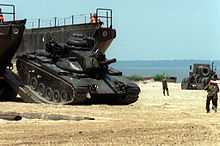
The M60A2 was intended as a stop-gap solution until the projected replacement by the MBT-70.[8] The M60A2, nicknamed the "Starship"[9] due to its Space Age technology, featured an entirely new low-profile turret with a commander's machine-gun cupola on top, giving the commander a good view and field of fire while under armor but spoiling the low profile. It featured a 152 mm (6.0 in) main gun similar to that of the M551 Sheridan light tank, which fired conventional rounds as well as the MGM-51 Shillelagh anti-tank missile system. The fitting of a CBSS (closed breech scavenger system), which used pressurized air to clear the breech after each shot, solved the problem of unburnt propellant from the main gun rounds fouling the barrel and pre-detonating subsequent rounds. The M60A2 proved a disappointment, though technical advancements would pave the way for future tanks; the MBT-70, which relied on much of this technology as it was used in the M60A2, never advanced beyond prototype stage though. The Shillelagh/M60A2 system was phased out from active units by 1981, and the turrets scrapped. Most of the M60A2 tanks were rebuilt as M60A3, or the hulls converted to armored vehicle-launched bridge (AVLB) vehicles.[9]
M60A3 series
In 1978, work began on the M60A3 variant. It featured a number of technological enhancements, including smoke dischargers, a new flash-lamp pumped ruby-laser based rangefinder (AN/VVG-2) that could be used by both commander and gunner, and an M21 ballistic computer, and a turret stabilization system.
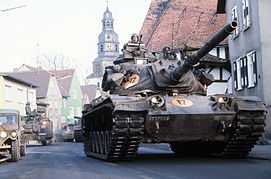
Late production M60A3s omitted the commander's cupola (Israeli Defence Force armor doctrine required tank commanders to fight commander-exposed, and it was discovered that non-penetrating hits upon the vehicle could dislodge the cupola from its mount while the commander was in it). The remote-controlled M85 machinegun was relatively ineffective in the anti-aircraft role for which it was designed compared to a conventional pintle mount. Removing the cupola lowered the vehicle's relatively high silhouette. The cupola's hatch also opened toward the rear of the vehicle and was dangerous to close if under small-arms fire owing to an open-locking mechanism that required the user to apply leverage to unlock it prior to closing.[citation needed]
The M60A3 was phased out of US service in 1997,[10] but it has remained a front-line MBT into the 21st century for a number of other countries.
While overall a less effective tank than the M1 Abrams, the M60A3 did have some advantages over some M1 models:[citation needed]
- The M60A3 TTS had a better thermal imaging system than that of M1 tanks up into the 21st century, when many M1s were upgraded with newer 2nd generation systems.
- The M60A3 had an exterior phone for infantry to talk directly to the crew inside, though this feature was removed from most M60A3's in its later life. This feature was also installed on some M1 tanks with the TUSK upgrade kit.
- The M60A3's diesel engine had lower overall performance, but also it had lower cost, requires less maintenance, and better fuel efficiency.
- The exhaust temperature of an M1's turbine is very high, which makes it dangerous for infantry to take cover behind it. This is not the case with the diesel engine on the M60.
- The escape hatch located under the hull of the M60A3 is not present on the M1 Abrams due to its low ground clearance, making it more difficult for the crew to escape a battle-damaged Abrams or evacuate casualties than from an M60A3.
- The M60 series' L68A1 105 mm main gun fires a much wider variety of ammunition than the 120 mm smoothbore on the M1 series, because of the nature of the smooth-bore cannon.
- The M60 series has instrumentation that allows indirect fire as ad-hoc artillery if needed by virtue of having a compass on board.
An M60A3 TTS was involved in a civilian police chase in 1995, when one was stolen by Shawn Nelson from a California Army National Guard armory and taken on a rampage through San Diego, California. Nelson was killed by police when he refused to surrender after the tank became stuck on concrete freeway dividers. News footage of this incident has been shown numerous times on various television programs.
Service history
United States
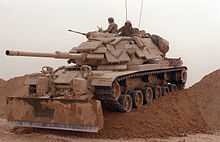
The M60-based M60 AVLB (Armored Vehicle Launch Bridge) and the M728 Combat Engineer Vehicle were the only variants of the M60 deployed to South Vietnam. The AVLB, commonly referred to as the "bridge tank", was mounted on an M60 tank hull, and the M728 Combat Engineer Vehicle was an M60 tank mounting a short-tubed 165 mm (6.5 in) main gun that fired a shaped charge.[9]
Late in the M60's U.S. Army service a number of prototype upgrades were evaluated. These were passed over in favor of simply producing more M1 Abrams. Due to the end of the Cold War, surplus US Army M1s were absorbed into the remaining USMC units, allowing the Marine Corps to become an all-M1 tank force at reduced cost. Except for a small number in active service, most M60s were placed in reserve, with a few being sold to US allies.
The M60A3 participated in close air support trials with the F-16 in the 1980s. M60A1s are still used by the USAF for testing of ground radar equipment on new aircraft and for ground force adversarial work at Red Flag at Nellis AFB Nevada.[citation needed]
USMC M60A1 tanks were used in Grenada and Beirut in 1983. In February 1991 USMC M60A1 ERA tanks rolled into Kuwait city after a two-day tank battle at the Kuwait airport.
During Operation Desert Storm in 1991 at least one US Air Force unit was equipped with M60s. The 401st TFW (P), deployed to Doha, Qatar had two M60s for use by explosives ordnance disposal personnel. It was planned that using the MBTs would allow the EOD crews to remove unexploded ordnance from tarmac runway and taxiway surfaces with increased safety.[11]
Israel


The Israel Defense Forces (IDF) purchased its first M60A1 tanks from the US in 1971. M60s and M60A1s saw action with Israel during the 1973 Yom Kippur War in both the Sinai and the Golan Heights (although mainly in the Sinai). The United States sent additional M60s to Israel just before and during hostilities. Following the war, the IDF received many more M48s, M60s and M60A1s from the U.S. Israel further upgraded their inventory of M60s prior to their use in the invasion of Lebanon in the 1982 Lebanon War. The Israeli modifications included new tracks and explosive reactive armor (ERA). This variant was known as the Magach. Further work in Israel has been done on the upgraded Magach models, adding new armor, new fire control system, a thermal sleeve and smoke dischargers. The latest versions, the Magach 7 (with variants A through C), are in use with some IDF units.
In July 2013, Israel began a program called Teuza (boldness) for the purpose of turning some military bases into sales lots for obsolete IDF equipment. Older models that are not suited for Israel's forces will be sold off, or sold for scrap if there are no buyers. M60A1/A3 and Magach tanks are among those being offered. Main buyers are expected from Latin American, Asian, and African countries.[12]
Kuwait
The M60A1 RISE Passive of the U.S. Marines saw action during Operation Desert Storm in the 1991 Persian Gulf War, opposing Iraqi armor which included the T-54, T-55, T-62, Type 69, and T-72. The M60A1s were fitted with add-on explosive reactive armor (ERA) packages and supported the drive into Kuwait City where they were involved in a two-day tank battle at the Kuwait airport with ten tanks lost. They saw service with the United States Marine Corps and the Saudi Arabian Army.[13][14]
Other users
As of 2005, M60 variants were in service with Bahrain, Bosnia, Brazil, Egypt, Greece, Israel, Jordan, Portugal, Spain, Tunisia, Turkey, Philippines, Thailand, Taiwan, Iran, and some other nations to varying degrees.[15] Royal Thai Army M60A3s were engaged in combat to recapture Border Post 9631 from Myanmar Army forces in 2001, and reportedly exchanged fire with Type 69 tanks.
The US continues to have significant stockpiles of M60s waiting to be scrapped, sold-off, converted, or used as targets in weapons testing. Some vehicles that use the chassis are still in use, however. Most of the M60s still used are much upgraded models. Pattons formed the basis for many 'new' tank designs, some using the chassis but with all-new turrets others using various upgrade packages. Jordan for example, is modifying two battalions of M60A3 with the IFCS system.
Greece offered to donate 13 M60A3 tanks to Afghanistan in 2007.[16]
Combat performance

The M60A1/A3s performed well against opposing tanks such as T-55s, T-62s and Type 69s in various conflicts including the Yom Kippur War, Lebanon and the battle for the Kuwait airport. The Marine Corps M60A1s had ERA that helped to protect them, and the Iraqi tank crews were not well trained and were using older T-55s and T-62s. However, Iranian M60A1s performed poorly against Iraqi tanks such as T-62s and T-72s. In early 1981, three Iranian armored brigades faced three Iraqi armored regiments. During the four-day tank battle 250 Iranian M60A1 and Chieftain tanks were destroyed and captured. The Iraqis lost 50 T-62 tanks. The remaining Iranian armor, turned about and withdrew. It was the biggest tank battle of the Iran-Iraq War.[17]
During the Yom Kippur War, Israeli M60 tanks fought effectively against Egyptian T-54/55 and T-62 tanks.[citation needed] However, many Israeli M60s were destroyed by Egyptian troops armed with AT-3 Sagger anti-tank missiles and RPG. Most of these were in the first few days following the Egyptian crossing of the Suez Canal. On 8 October 1973, two Israeli tank battalions, some 50 M60s, were destroyed in an ambush by Egyptian T-55 tanks during Operation Badr. In Israeli service, the type is highly regarded and has been updated through the years; it has earned praise for its firepower and maneuverability.[18][19][20][21] The M60 also preformed well in Operation Peace for Galilee in 1982. In combat south of Beirut some 400 Syrian T-55 T62 and T-72 tanks were destroyed by Israeli M60A1 and Merkava 1 tanks.[citation needed]
Variants

- XM60/M60: Bearing a strong familial resemblance to the M48, the M60 has a wedge shaped hull, three return rollers, and aluminum road wheels, features not found on previous M48s. Featured a turret with 105 mm M68 gun. Some early production units for this and for A1 version, did not have the commander's cupola.
- M60A1: First variant to feature the distinctive "needle-nose" long nosed turret, along with better armor protection and improved hydraulics.
- M60A1 AOS: Add-On Stabilization, introduced in 1972 for the M68 gun.
- M60A1 RISE: Reliability Improvements for Selected Equipment, featured improvements of almost all the basic systems including an upgraded engine design that allowed easier access to components to allow removing the engine pack in less time and a new track type, T142, that helped reduce wear and improve track life.
- M60A1 RISE Passive: RISE, but with a smaller infra-red/white light capable search-light and passive night vision equipment. USMC M60A1 RISE Passives were outfitted with explosive reactive armor (ERA) in the late 1980s.
- M60A1E1: Developmental test vehicles fitted with the 152 mm M162 gun-missile launchers.
- M60A1E2/M60A2: Turret design finalized, giving the distinctive "starship" look. A variant was tested with a remote controlled 20 mm cannon as well.
- M60A1E3: prototype, M60A1E2 fitted with 105 mm gun.
- M60A1E4: Experimental type with remote control weapons.
- M60A3: M60A1 fitted with a laser rangefinder, M21 solid state ballistic computer, and a crosswind sensor. Late production units omitted the commander's cupola.
- M60A3 TTS: Tank Thermal Sight; M60A3s fitted with the AN/VSG-2 thermal sight.
- M60 Super/AX: Uparmored versions with minor improvements. Main version also featured no optical rangefinder.
- M60-2000/120S: M60/Abrams hybrid vehicle developed by General Dynamics Land Division. Not adopted by the United States military.
Specialized
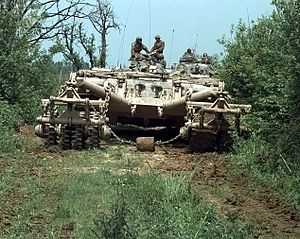
- M60AVLB: baseline M60-based chassis armoured vehicle-launched bridge with 60-foot (18 m) scissors bridge.
- M60A1: Upgraded version of the M60 AVLB based on the M60A1.
- M60 AVLM: Armored Vehicle Launched MICLIC (Mine-Clearing Line Charge), modified AVLB with up to 2 MICLIC on M60 chassis.
- M60 Panther: M60 modified into a remotely controlled mine clearing tank.
- M728 CEV: baseline M60-based Combat Engineer Vehicle fitted with a folding A-frame crane and winch attached to the front of the turret, and an M135 165mm demolition gun. Commonly fitted with the D7 bulldozer blade, or a mine-plow for the clearing of land mines.
- M728A1: Upgraded version of the M728 CEV based on the M60A1.
Additional equipment:
- M9: Bulldozer and earthmoving equipment for the M60.
International
- M60T or Sabra: highly upgraded version of the M60A1 which is designed for the MBT modernization program of the Turkish Army. It features a new 120 mm smoothbore gun, electric stabilization system, new fire control system, and new armor package.[22][23][24] M60T is also known as Sabra Mk.II.
- E-60
- E-60: basically unmodified main production M60
- E-60A: basically unmodified M60A1
- E-60A Dozer: version with M9 bulldozer kit installed
- E-60B: basically unmodified M60A3
- M60VLPD 26/70E: Spanish Army bridgelayer based on the M60 with "Leguan bridge system". 12 converted from M60A1.
- M60CZ-10/25E Alacran: Spanish Army combat engineer variant. 38 converted from M60A1.
- Israeli variants: Many of the Israeli M60s have been upgraded with additional reactive or passive armor, drastically improving their armor protection. These up-armored versions are called Magach 6 / Magach 7.
- M60 Phoenix: Jordanian upgrade, being carried out by the King Abdullah II Design And Development Bureau.[25] Upgrade includes shoot-on-move capabilities, increased firepower (with a RUAG 120 mm smoothbore gun) and armor protection scheme upgrade.
- Samsam (Sword): Iranian upgraded version of M60A1 tank, fitted with reactive armor (presumably Kontakt-5), EFCS-3 Fire Control system, Laser warning system and IR jammers.[26]
Operators

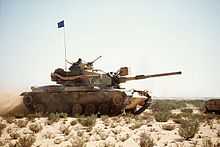
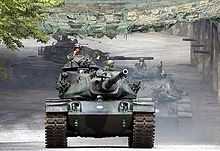
Current
 Bosnia and Herzegovina: 85 M60A3 40 delivered in 2012 for exercise and main mission tasks.
Bosnia and Herzegovina: 85 M60A3 40 delivered in 2012 for exercise and main mission tasks. Bahrain: 180 M60A3
Bahrain: 180 M60A3 Brazil: 91 M60A3 TTS[27]
Brazil: 91 M60A3 TTS[27] Egypt: 1016 M60A3/700 M60A1 total:1716
Egypt: 1016 M60A3/700 M60A1 total:1716 Iran: 150 M60A1(2010). One of firsts delivered M60 tanks was hijacked to Soviet Union in 1961.[28][29]
Iran: 150 M60A1(2010). One of firsts delivered M60 tanks was hijacked to Soviet Union in 1961.[28][29] Israel: 711 Magach 6 Archuv and Magach 6 Archuv 2, 111 Magach 7 (to be increased by 74 before 2010).[30]
Israel: 711 Magach 6 Archuv and Magach 6 Archuv 2, 111 Magach 7 (to be increased by 74 before 2010).[30] Jordan: 354 .
Jordan: 354 . Lebanon: 66[31] A3 series, first 10 arrived on 22 May 2009.[32]
Lebanon: 66[31] A3 series, first 10 arrived on 22 May 2009.[32] Morocco: 260 M60A3TTS, 167 M60A3 [33][34][35]
Morocco: 260 M60A3TTS, 167 M60A3 [33][34][35] Oman: 93
Oman: 93 Saudi Arabia: 450 M60A1 and M60A3
Saudi Arabia: 450 M60A1 and M60A3 Spain: 17 M60A3TTS (Infantería de Marina), 38 M60CZ-10/25E, 12 M60VLPD-26/70E (Spanish Army)
Spain: 17 M60A3TTS (Infantería de Marina), 38 M60CZ-10/25E, 12 M60VLPD-26/70E (Spanish Army) Sudan: 20[36]
Sudan: 20[36] Portugal: Around 40 operational
Portugal: Around 40 operational Republic of China (Taiwan): 450 M60A3 TTS[37]
Republic of China (Taiwan): 450 M60A3 TTS[37] Thailand: 178 M60A1/A3 ex–U.S. Army
Thailand: 178 M60A1/A3 ex–U.S. Army Tunisia: 84
Tunisia: 84 Turkey: 658 M60A3TTS,104 M60A1 RISE,170 M60T total:866
Turkey: 658 M60A3TTS,104 M60A1 RISE,170 M60T total:866 Yemen: 240
Yemen: 240
Former
 Austria: Sold to Egypt
Austria: Sold to Egypt Greece: 357 M60A1 RISE Passive and 312 M60A3 TTS were received
Greece: 357 M60A1 RISE Passive and 312 M60A3 TTS were received Italy: 300
Italy: 300 United States: Retired from service, some in reserve/storage.
United States: Retired from service, some in reserve/storage. Ethiopia
Ethiopia
See also
- Magach 6 & 7: series of Israeli upgrades to the M60 platform
- Gun data computer, models M16, M19, M21
- Shawn Nelson: Went on a rampage in Clairemont, San Diego in a stolen M60A3
- G-numbers (SNL G292)
Comparable contemporaries
References
- Notes
- ↑ 1.0 1.1 1.2 1.3 1.4 1.5 1.6 1.7 1.8 1.9 Foss, p. 166
- ↑ 2.0 2.1 Hunnicutt pp. 6, 408.
- ↑ Hunnicutt
- ↑ Hunnicutt p. 165
- ↑ Hunnicutt p. 157.
- ↑ Hunnicutt/Firepower p. 181.
- ↑ 7.0 7.1 "M60 Patton Main Battle Tank (USA)". Historyofwar.org. Retrieved 2010-03-26.
- ↑ United States. Congress. House. Committee on Armed Services (1978). Hearings, reports and prints of the House Committee on Armed Services, Issue 56. U.S. GPO. p. 8961. Retrieved 19 February 2011.
- ↑ 9.0 9.1 9.2 "Development and History of the M-60 tank". Patton Mania.
- ↑ Development and History of the M-60 tank
- ↑ The Gulf War with the 401TFW/614TFS Lucky Devils
- ↑ "Israeli army is planning to sell second-hands Merkava main battle tanks and F-16 fighter aircraft". Armyrecognition.com, 16 July 2013.
- ↑ David Isby, Lon Nordeem. M60 vs T-62, p. 73. Osprey Publishing, 2010.
- ↑ Zaloga, Stiven. T-62 Main Battle Tank 1965–2005, стр. 46-47. Osprey Publishing, 2009.
- ↑ http://www.acig.org/artman/publish/article_346.shtml
- ↑ . US. Central Command
- ↑ «The Iran-Iraq War» Efraim Karsh pp.29-30.
- ↑ Gawrych, Dr. George W. (1996). The 1973 Arab-Israeli War: The Albatross of Decisive Victory. Combat Studies Institute, U.S. Army Command and General Staff College. pp. 43-50.
- ↑ Hammad, Gamal (2002). Military Battles on the Egyptian Front (First ed.). Dār al-Shurūq. pp. 176-177.
- ↑ O'Ballance, Edgar (1997). No Victor, No Vanquished: The Arab-Israeli War, 1973. Presidio. p. 104.
- ↑ el-Shazly, Saad (2003). The Crossing of the Suez, Revised Edition (Revised ed.). American Mideast Research. pp. 233.
- ↑ Turkish Defence Industry Products M60 T
- ↑ M60 Tank Modernization Project
- ↑ Jane's Defence Weekly – June 06, 2007
- ↑ "Projects – Phoenix M60 Upgrade". KADDB. Retrieved 2010-03-26.
- ↑ آشنایی-با-صمصام-ناشناخته-ترین-تانک-ایرانی-عکس (in Persian), mashreghnews.ir
- ↑ Army Equipment – Brazil
- ↑ John Pike (2009-02-13). "Iranian Ground Forces Equipment". Globalsecurity.org. Retrieved 2010-03-26.
- ↑ Zaloga, Steven J. and Hugh Johnson (2004). T-54 and T-55 Main Battle Tanks 1944–2004. Oxford: Osprey. p.13
- ↑ Army Equipment – Israel
- ↑ "واشنطن تزوّد لبنان أسلحة ثقيلة قبل استحقاق حزيران" (in Arabic). Annahar Newspaper. April 9, 2009. Retrieved 2009-04-09.
- ↑ "Heavy U.S. Military Aid to Lebanon Arrives ahead of Elections". Naharnet Newsdesk. April 9, 2009. Retrieved 2009-04-09.
- ↑ 300 Ex-US M60A1 from 1991 to 1994 and 120 M60A3TTS and 7 M60A1 in 1997
- ↑ "Morocco's M60A1 tanks were upgraded to M60A3's as these became available."
- ↑ 140 Upgraded to M60A3TTS in 2009 Source: Army-guide
- ↑ Richard Lobban, Jr. Global Security Watch: Sudan (2010 ed.). Greenwood Publishing Group. p. 182. ISBN 978-0-313-35332-1.
- ↑ Army Equipment – Taiwan
- Bibliography
External links
| Wikimedia Commons has media related to M60 tanks. |
- M60A3 Main Battle Tank on army-technology.com
- 105 mm Gun M60 page on AFV Database site
- Patton-Mania site
- [http://www.militaryimages.net/photopost/showphoto.php/photo/12027/limit/recent: M60 Series on MilitaryImages.Net]
- The short film Big Picture: M-60 King of Armor is available for free download at the Internet Archive [more]
| ||||||||||||||
| |||||||||||||||||||||||
| |||||||||||||||||
